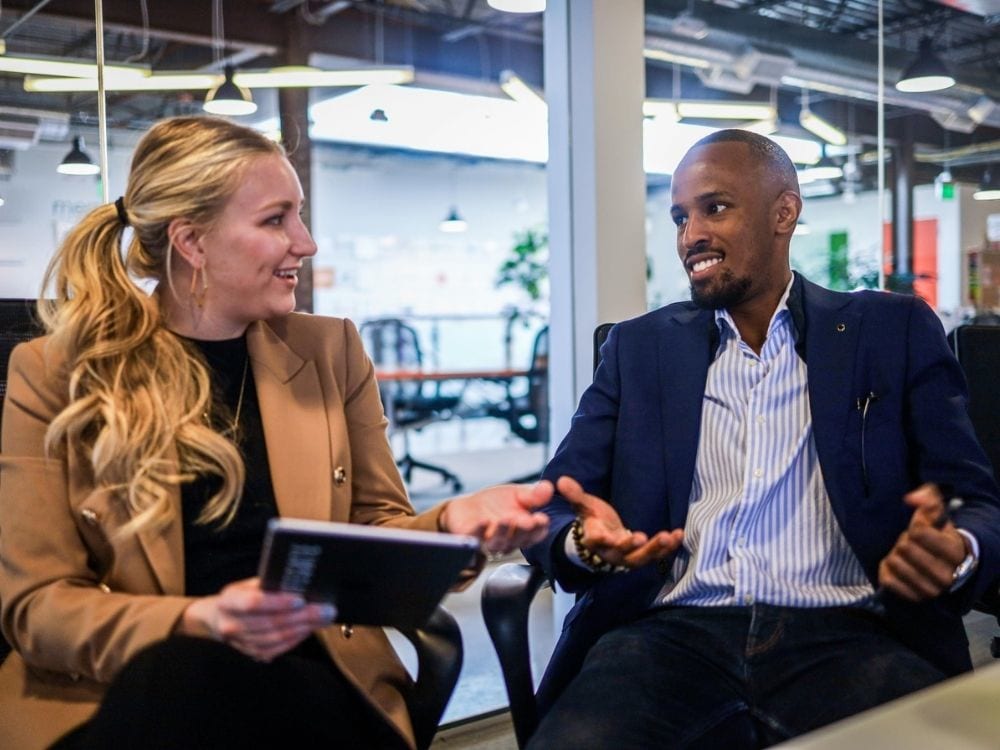When you boil it down to the basics, there is one simple goal of any B2B business: get buyers through your sales funnel and into the decision stage of the buyer journey.
The decision stage is where your sales team shines, and can close deals with warm leads who are looking for your product or service.
But how do you get customers through your funnel and into the decision stage?
A lot of businesses do well marketing to customers in the earlier stages, but struggle to nudge them along to that final purchase decision.
In this post, we’ll show you the stages of the buyer journey, what your customers are looking for in the decision stage, and how you can market to them more effectively to increase conversions.
Want to know the four key factors that influence buyer behavior and what you should be doing to help overcome obstacles? Check out our guide on B2B buying behavior here.
What is the Decision Stage?
The decision stage is the final stage of the buyer journey. Although complex and unique to each business, the buyer journey is generally broken down into three distinct stages to make marketing and sales much more targeted.
The three stages are:
- The Awareness Stage: The buyer has just discovered your business. Although they don’t know you yet, they are likely looking for a solution your business offers.
- The Consideration Stage: The buyer has taken an interest in a specific product or service you offer and is researching the different options available.
- Decision Stage: The buyer makes the firm decision to buy and it’s your sales team’s job to close the deal.
As you can see, the decision stage is where the buyer makes a firm choice to buy a product or service. They’ve gone through the awareness and consideration stages and now feel confident they have all the information they need to make an informed purchase decision.
Although the first two stages are critical to getting your customers to this final stage, the decision stage has the highest stakes.
This is where your sales team needs to convince the customer to make that buying decision, but it’s also the stage where you might lose a customer and never hear from them again.
The Goals of the Decision Stage
There are two goals of the decision stage:
- Understanding buyer obstacles and helping them overcome them.
- Having a unique sales proposition (USP) that helps you stand out from the competition and close the deal.
A lot of B2B businesses will focus heavily on promotion, sales, and offers during this decision stage, but what your customer really wants is to be understood.
No matter how good your product or service is, your sales team needs to be able to nurture customers and demonstrate to them that your product or service is the right choice.
To help you streamline your goals and close more customers in this final stage, here are some important questions to ask yourself:
- Who is involved in the decision-making process? How many people do your sales team need to get on board?
- Do your buyers have expectations about trying your product or service before making the final decision? Can you feasibly offer a free trial?
- Are there preparations buyers need to have in place before making a purchase decision? How can you help them prepare?
- What alternatives are there to your product or service? How can you demonstrate yours is the best choice?
What Types Of Questions Do Buyers Ask In The Decision Stage?

By the time the buyer gets to the decision stage, they’ve done their research and have a list of viable options they are considering. But that doesn’t mean they are ready to make a firm choice.
Once they’ve got a shortlist of potential companies they are thinking of buying from, there are still some key questions they’ll be asking.
These questions are usually obstacles that the customer is trying to overcome, so it’s your job to answer these questions and prove you are the best choice:
- How much will this product/service cost? Do the benefits outweigh the cost?
- Can I get a free trial to make sure I’m happy with the service?
- What is the customer service like? Are they responsive to my concerns?
- What do reviews say? Are previous customers happy with the product/service?
- Does this product/service require preparation? Am I ready to make this final purchase decision?
Each buyer is looking for solid answers to the final questions that are standing in the way of making their final decision.
The more information you can provide that helps them overcome these queries, the more likely you are to acquire them as a loyal customer.
If you’re struggling to understand the obstacles your customers are facing, reach out to previous customers and ask them. No one knows your customer base like those who have already bought your products.
Marketing Strategies and Tips for the Decision Stage
Now you know what the buyer is facing in the decision stage, you can target your final stage of marketing much more strategically.
Here are some of the top marketing strategies for the decision stage and how you can implement them.
1. Targeted Offers
Each stage requires different types of offers to appeal to the mindset of the buyer. For example, in the consideration stage, the buyer isn’t ready to speak to your sales team, and so you’re better off showing them informative content that helps them with their product research.
On the other hand, once the buyer enters the decision stage, they are much more ready for consultations, product demos, and specific offers.
So, when you’re planning out any of the marketing strategies below, make sure you target them to the buyer in the decision stage and understand the type of language they will resonate with most.
2. Free Trials and Demos
A key way of closing a buyer in the decision stage is with a free trial or product demo. In the B2B space, purchase decisions are usually serious investments so there is going to be serious pushback about making that final decision.
Offering a live demo, free trial period, or consultation will help your client see the benefit of your product or service in action and help them decide if it’s the right fit for them.
Check out our guide on how to nail your sales demo and increase sales here.
3. Consultations with Sales Reps
Buyers are ready to talk to sales teams when they are in the decision stage and may have final questions they want answered.
Make sure your sales team is available quickly and has the right answers to appeal to buyers.
To ensure your customers aren’t left hanging, implementing an AI chatbot will help answer FAQs instantly and open up that channel of communication with potential buyers even when your sales reps aren’t available.
Sales Strategies for the Decision Stage
Image: https://unsplash.com/photos/R3jJvOSzjrk

When it comes to sales, the decision stage is where you can focus less on education and more on promotion. Even so, all of your promotional content should be aimed at helping potential buyers overcome hurdles.
With that in mind, here are some specific sales strategies that your sales team can use to improve conversions.
Free trial
A free trial is the best sales strategy for onboarding new clients. Studies show the average conversion rate is from 10 to 25% for opt-in trials, but this jumps to 50% of opt-out trials.
If you have software, digital services, or tools, a free trial helps buyers figure out if it fits their business before committing to a purchase. This helps them overcome the most prevalent obstacle – loss aversion.
Demos
Having sales reps demo your product or service is another great sales strategy that overcomes another key struggle – the status quo buyer effect.
Buyers have to be facing a significant problem to put in the time and money to implement something new.
If you can show them your product or service is simple to use and easy to implement with a free demo, you’ll instantly overcome this hurdle.
Expert advice
Your sales rep should know your product or service inside out. Equally, they should understand the major problems your potential buyers face.
By offering expert advice to buyers that is personalized to their specific issues, you’ll show buyers your brand is a leader in the field and is the right fit for their needs.
The expert advice should include your product or service, but go beyond a simple sales pitch. Sales reps should spend time understanding the key issues a buyer is facing and give them personalized advice on how to solve them.
Estimates and quotes
A buyer who is interested in an estimate or quote for your product or service is a hot lead. They are on the cusp of a buying decision and the last hurdle they are facing is the price point.
To overcome this, make sure you understand the pricing models that appeal most to potential buyers.
This will depend on your product or industry but by offering more options, you’ll secure a wider range of clients. For example:
- Is a low monthly fee more appealing than a one-off payment?
- Do you offer a discount for volume orders?
- Do you have additional services that make an offer more appealing?
By personalizing quotes and understanding what appeals most to your audience, you’ll see a higher conversion rate.
Coupons and discount codes
This is a well-known if not overused sales method for any business, including those in the B2B space.
If you do decide to use coupons or discount codes, try to use randomized codes (DJGE67DHF2) rather than generic ones (WELCOME10).
This will feel instantly more personalized to the buyer and you’ll be able to track which buyers used the code.
Keep in mind that some discounts work better than others. In fact, you need to offer a significant discount to be appealing to most buyers – 10% is so overused that many customers don’t see it as a worthwhile discount anymore.
How to Convert a Buyer During the Decision Stage

A key question many marketers have is how to convert buyers during the decision stage. It’s easy to get stuck in the cycle of content creation and forget to promote enough to nudge your buyers over the edge into a purchase decision.
To avoid coming across as salesy, you should aim to provide 30% educational content and 70% promotional content when marketing to buyers in the decision stage.
Clear CTAs
When creating content or marketing materials, make sure you have clear, effective CTAs that encourage your buyer to take action.
The easier you can make the purchase decision, the better. So whether you need buyers to sign up for a free trial, pay a deposit, or speak to a sales rep, reduce the number of steps they need to take as much as possible.
Automate your outreach
Your sales team can’t be around to answer every question and query of potential buyers. In fact, you want them to spend their time solely with hot leads who are ready to buy.
However, you don’t want warm leads dropping off in the decision stage through a lack of communication.
That’s where automation comes in. But automating outreach to potential buyers you can easily help them overcome the final obstacles they are facing, warm them up into hot leads, and get them ready for your sales team – all on autopilot.
With bant.io, you get automated email campaigns (the best way to communicate with potential leads) that utilize our 3% high-performing email sequences from +12,000 campaigns.
We’ve got a proven system for converting leads and will help you secure customers who are stuck in the decision stage.
Start Closing More Customers in the Decision Stage
From social and email outreach to implementing a high-converting sales chatbot, we’ve got all the tools you need to close more deals with buyers in the decision stage and get your sales funnel moving more efficiently.
We practice what we preach here at bant.io – we have free demos to help you figure out if our software is the right fit for you, as well as simple plans personalized to your business.
Let us help you engage effortlessly with your buyers when they’re in the decision stage. Schedule a demo today and automate your outreach!

